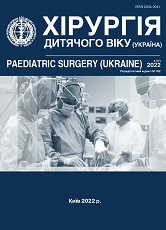Working orthopedic classification of the functional state of the lower extremities in congenital vascular malformations
DOI:
https://doi.org/10.15574/PS.2022.77.84Keywords:
congenital vascular malformations, working orthopedic classificationAbstract
Purpose - to systematize orthopedic pathology and develop working orthopedic classification of the functional state of the lower limbs in congenital vascular malformations based on the analysis of clinical manifestations of various forms diseases.
Materials and methods. 38 patients with congenital vascular malformations were examined. Patients were assigned to the working classification scheme of congenital vascular malformations "VASC+T": arteriovenous - 25, venous - 7, capillary - 4, lymphatic - 2. The clinical course of the disease was evaluated (pain syndrome, clinical stage of chronic venous disease according to the CEAP classification). Diagnosis of orthopedic pathology based on clinical examination.
Results. Among all patients, 74% had an orthopedic pathology, 53% had a combination of several orthopedic manifestations. A working clinical and orthopedic classification of the functional state of the lower extremities in congenital vascular malformations has been developed, taking into account the intensity of the pain syndrome, the type of orthopedic pathology and its severity, and the clinical class of chronic venous disease. The distribution of patients was carried out according to the created classification: non-clinical group - 26%; I clinical group - 29%; II clinical group - 34%; III clinical group - 11%.
Conclusions. A working orthopedic classification of the functional state of the lower limbs in congenital vascular malformations has been created, which takes into account the pain syndrome, leading orthopedic manifestations (difference in the length of the lower limbs, contractures of large joints, foot deformities) and their severity, the clinical class of chronic vein disease. The developed working clinical-orthopedic classification of the functional state of the lower extremities in congenital vascular malformations will allow to create a basis for the choice of treatment tactics for the pathology of the musculoskeletal system in this category of patients.
The research was carried out in accordance with the principles of the Declaration of Helsinki. The research protocol was approved by the Institution's Local Ethics Committee. Informed consent was obtained from the children's parents (or their guardians) for the research.
No conflict of interests was declared by the author.
References
Breugem CC, Maas M, Breugem SJ, Schaap GR, van der Horst CV. (2003). Vascular malformations of the lower limb with osseous involvement. J Bone Joint Surg Br. 85(3): 399-405. https://doi.org/10.1302/0301-620X.85B3.13429; PMid:12729117
Campbell TM, McGonagle D. (2021). Flexion contracture is a risk factor for knee osteoarthritis incidence, progression and earlier arthroplasty: data from the osteoarthritis initiative. Ann Phys Rehabil Med. 64(2): 101439. https://doi.org/10.1016/j.rehab.2020.09.005; PMid:33065299
Charles J, Scutter SD, Buckley J. (2012). Static ankle joint equinus: toward a standard definition and diagnosis. J Am Podiatr Med Assoc. 100(3):195-203. https://doi.org/10.7547/1000195; PMid:20479450
Chernukha LM, Kashirova EV (2015). Classification of congenital vascular malformations: a tribute to fashionable trends or an urgent necessity? View of a vascular surgeon. Pediatric surgery. 46-47 (1-2): 6-17.
Dan VN, Sapelkin SV. (2008). Angiodysplasia (congenital malformations of blood vessels). Moscow: Verdana: 200.
Guk Yu, Chernukha L, Zyma A, Vyderko R, Cheverda A et al. Orthopedic manifestations in patient with arteriovenous malformations of the lower limbs. Edizioni Minerva Medica. Acta Phlebologica. Preprint.
Harvey WF, Yang M, Cooke TD, Segal NA et al. (2010). Association of leg-length inequality with knee osteoarthritis: a cohort study. Annals of internal medicine. 152(5): 287-295. https://doi.org/10.7326/0003-4819-152-5-201003020-00006; PMid:20194234 PMCid:PMC2909027
Huk YM, Chernukha LM, Zyma AM, Cheverda AI, Kincha-Polishchuk TA, Vyderko RV. (2021). Clinical and orthopedic manifestations of congenital vascular malformations of the lower extremities. Orthopedics, traumatology and prosthetics. 624(3): 49-53. https://doi.org/10.15674/0030-59872021349-53
Kalson NS, Borthwick LA, Mann DA, Deehan DJ, Lewis P et al. (2016). International consensus on the definition and classification of fibrosis of the knee joint. The bone & joint journal. 98-B(11): 1479-1488. https://doi.org/10.1302/0301-620X.98B10.37957; PMid:27803223
Kalson NS, Borthwick LA, Mann DA, Deehan DJ, Lewis P et al. (2016). International consensus on the definition and classification of fibrosis of the knee joint. The bone & joint journal. 98-B(11):1479-1488. https://doi.org/10.1302/0301-620X.98B10.37957; PMid:27803223
Kim YW, Lee SH, Kim DI, Do YS, Lee BB. (2006). Risk factors for leg length discrepancy in patients with congenital vascular malformation. J Vasc Surg. 44(3): 545-553. https://doi.org/10.1016/j.jvs.2006.05.035; PMid:16950432
Korzh NA, Radchenko VA. (2015). Orthopedist's Handbook. Kyiv: Library "Health of Ukraine".
Lee BB, Laredo J, Lee TS et al. (2007). Terminology and classification of congenital vascular malformations. Phlebology. 22(6): 249-252. https://doi.org/10.1258/026835507782655236
Malan E. (1974). Vascular malformations (angiodysplasias). Milan: Carlo Erba Foundation: 213.
Reid DC, Smith B. (1984). Leg length inequality: a review of etiology and management. Physiotherapy Canada. 36: 177-182.
Spencer SA, Sorger J. (2014). Orthopedic issues in vascular anomalies. Semin Pediatr Surg. 23(4):227-32. https://doi.org/10.1053/j.sempedsurg.2014.06.015; PMid:25241103
Veselov AG. (2013). Orthopedic correction for dysplasia of the trunk veins of the lower extremities in children. Dissertation author's abstract for the candidate of medical sciences degree, 14.01.19: children's surgery. St. Petersburg: 2013.
Downloads
Published
Issue
Section
License
Copyright (c) 2022 Paediatric Surgery (Ukraine)

This work is licensed under a Creative Commons Attribution-NonCommercial 4.0 International License.
The policy of the Journal “PAEDIATRIC SURGERY. UKRAINE” is compatible with the vast majority of funders' of open access and self-archiving policies. The journal provides immediate open access route being convinced that everyone – not only scientists - can benefit from research results, and publishes articles exclusively under open access distribution, with a Creative Commons Attribution-Noncommercial 4.0 international license(СС BY-NC).
Authors transfer the copyright to the Journal “PAEDIATRIC SURGERY.UKRAINE” when the manuscript is accepted for publication. Authors declare that this manuscript has not been published nor is under simultaneous consideration for publication elsewhere. After publication, the articles become freely available on-line to the public.
Readers have the right to use, distribute, and reproduce articles in any medium, provided the articles and the journal are properly cited.
The use of published materials for commercial purposes is strongly prohibited.

